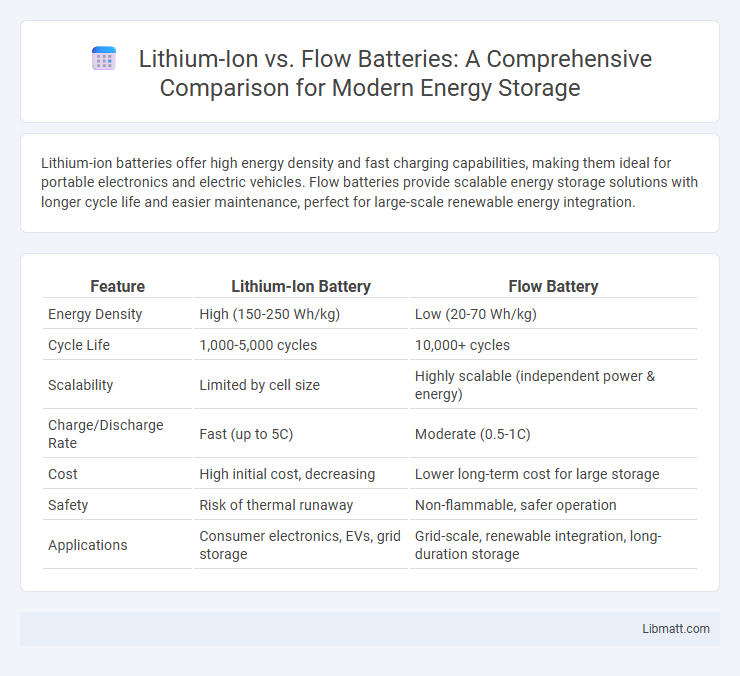Lithium-ion batteries offer high energy density and fast charging capabilities, making them ideal for portable electronics and electric vehicles. Flow batteries provide scalable energy storage solutions with longer cycle life and easier maintenance, perfect for large-scale renewable energy integration.
Table of Comparison
| Feature | Lithium-Ion Battery | Flow Battery |
|---|---|---|
| Energy Density | High (150-250 Wh/kg) | Low (20-70 Wh/kg) |
| Cycle Life | 1,000-5,000 cycles | 10,000+ cycles |
| Scalability | Limited by cell size | Highly scalable (independent power & energy) |
| Charge/Discharge Rate | Fast (up to 5C) | Moderate (0.5-1C) |
| Cost | High initial cost, decreasing | Lower long-term cost for large storage |
| Safety | Risk of thermal runaway | Non-flammable, safer operation |
| Applications | Consumer electronics, EVs, grid storage | Grid-scale, renewable integration, long-duration storage |
Introduction to Lithium-Ion and Flow Batteries
Lithium-ion batteries, widely used in portable electronics and electric vehicles, offer high energy density and rapid charge capabilities, making them ideal for applications requiring compact, lightweight power storage. Flow batteries, characterized by their scalable design and long cycle life, utilize liquid electrolytes stored in external tanks, providing flexible energy capacity suited for large-scale grid storage and renewable energy integration. Both technologies play crucial roles in advancing energy storage solutions, with lithium-ion excelling in mobility and flow batteries offering significant advantages in sustainability and lifespan for stationary applications.
Core Technology Overview
Lithium-ion batteries utilize intercalation chemistry where lithium ions move between the anode and cathode through a solid electrolyte, enabling high energy density and fast charging capabilities. Flow batteries store energy in liquid electrolytes contained in external tanks, allowing scalable capacity and long cycle life by separating power and energy components. Understanding these core technologies helps you choose the optimal battery system based on application requirements like energy density, scalability, and lifecycle.
Energy Density Comparison
Lithium-ion batteries offer a significantly higher energy density, typically ranging from 150 to 250 Wh/kg, making them ideal for applications requiring compact and lightweight power storage. Flow batteries, while having much lower energy density around 20 to 50 Wh/kg, provide the advantage of scalability and longer cycle life for large-scale energy storage systems. When choosing between these technologies, your priority on energy density versus lifecycle and scalability will determine the best fit for your energy storage needs.
Lifespan and Cycle Durability
Lithium-ion batteries typically offer a lifespan of 8 to 15 years with cycle durability ranging from 500 to 1,500 full charge-discharge cycles, making them ideal for applications requiring high energy density and frequent cycling. Flow batteries boast superior cycle durability exceeding 10,000 cycles and a longer lifespan often surpassing 20 years due to their unique design, which separates energy storage from power delivery. Your choice between lithium-ion and flow batteries should weigh the need for quick energy access against long-term durability and maintenance costs.
Charging and Discharging Efficiency
Lithium-ion batteries exhibit high charging and discharging efficiencies, typically around 90-95%, due to their low internal resistance and electrochemical stability. Flow batteries generally have lower efficiencies, ranging from 65-85%, because of energy losses related to electrolyte pumping and membrane resistance. Despite this, flow batteries offer better scalability and longer cycle life, making them suitable for large-scale energy storage despite slightly reduced efficiency.
Scalability and Application Suitability
Flow batteries offer superior scalability due to their design, where energy capacity can be increased simply by enlarging the electrolyte tanks, making them ideal for large-scale energy storage applications such as grid stabilization. Lithium-ion batteries provide higher energy density and faster response times, making them well-suited for portable electronics, electric vehicles, and applications requiring compact, efficient power sources. You should consider flow batteries for long-duration, scalable energy needs and lithium-ion for high-performance, compact applications.
Safety and Environmental Impact
Lithium-ion batteries offer high energy density but pose risks such as thermal runaway and flammability, which can impact safety in your applications. Flow batteries provide enhanced safety due to their non-flammable electrolytes and lower risk of overheating, making them more suitable for large-scale energy storage with minimal fire hazards. Environmentally, flow batteries often have a longer lifespan and use less toxic materials compared to lithium-ion batteries, reducing electronic waste and ecological impact.
Cost Analysis and Economic Viability
Lithium-Ion batteries typically have a higher upfront cost but offer superior energy density and longer cycle life, resulting in lower cost per kilowatt-hour over time. Flow batteries, while generally exhibiting lower initial costs and easier scalability, incur higher maintenance expenses and efficiency losses, affecting long-term economic viability. Your choice depends on specific application needs, scale, and budget constraints that balance initial investment against operational savings.
Current Market Trends and Adoption
Lithium-ion batteries dominate the current market due to their high energy density, rapid charging capabilities, and widespread use in electric vehicles and portable electronics. Flow batteries, while less common, are gaining traction for large-scale energy storage solutions because of their scalability, long cycle life, and enhanced safety features. Your choice between these technologies depends on whether you prioritize compact, high-performance batteries or durable, flexible storage systems for renewable integration.
Future Prospects in Energy Storage
Flow batteries offer scalable energy storage with long cycle life and rapid response times, making them promising for grid-level applications and renewable energy integration. Lithium-ion batteries dominate portable electronics and electric vehicles due to high energy density and decreasing costs but face challenges in lifespan and resource availability. Innovations in flow battery chemistries and lithium-ion recycling technologies will shape the future landscape of sustainable and efficient energy storage solutions.
Lithium-Ion vs Flow Battery Infographic

 libmatt.com
libmatt.com